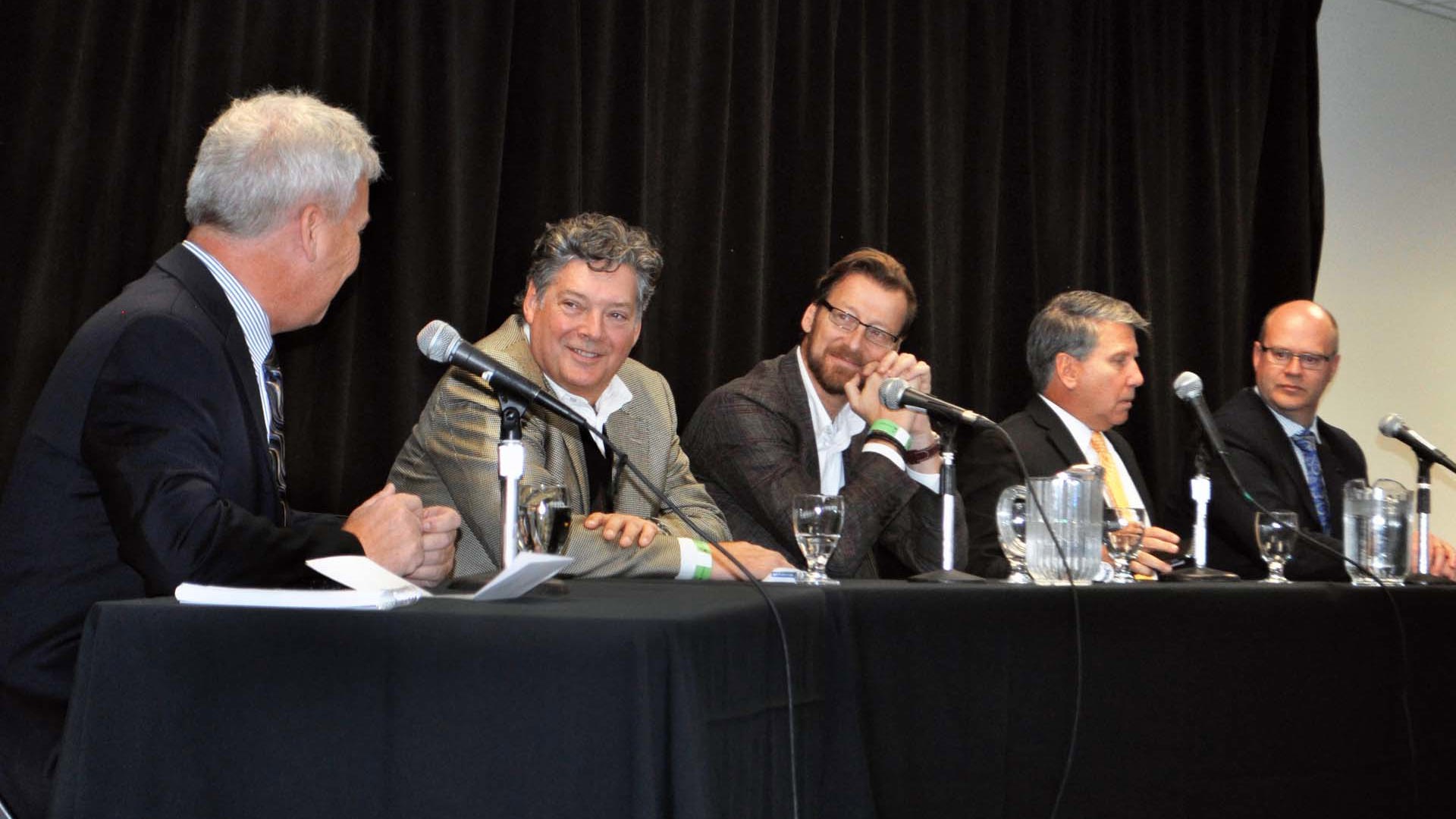Will we all be driving electric cars in the foreseeable future? Where does fuel cell technology fit into the mix? When will cars drive autonomously? Will we one day simply summon cars with our smartphones without ever actually owning one ourselves?
These questions were all broached through the eyes of Canadian automotive executives at a panel discussion hosted recently by the Automotive Journalists Association of Canada titled “The Future is Now.”
Five top executives from across the industry offered their perspectives on the burning topics of electrification, connectivity, and ride-sharing. In attendance:
• David Paterson, Vice President of Corporate Affairs for General Motors of Canada
• Wolfgang Hoffmann, President of Jaguar Land Rover Canada
• François Lefèvre, Chief Marketing Manager for the Nissan Leaf at Nissan Canada
• Don Romano, President and CEO of Hyundai Canada
• Ted Lancaster, Vice-President and Chief Operating Officer of Kia Canada
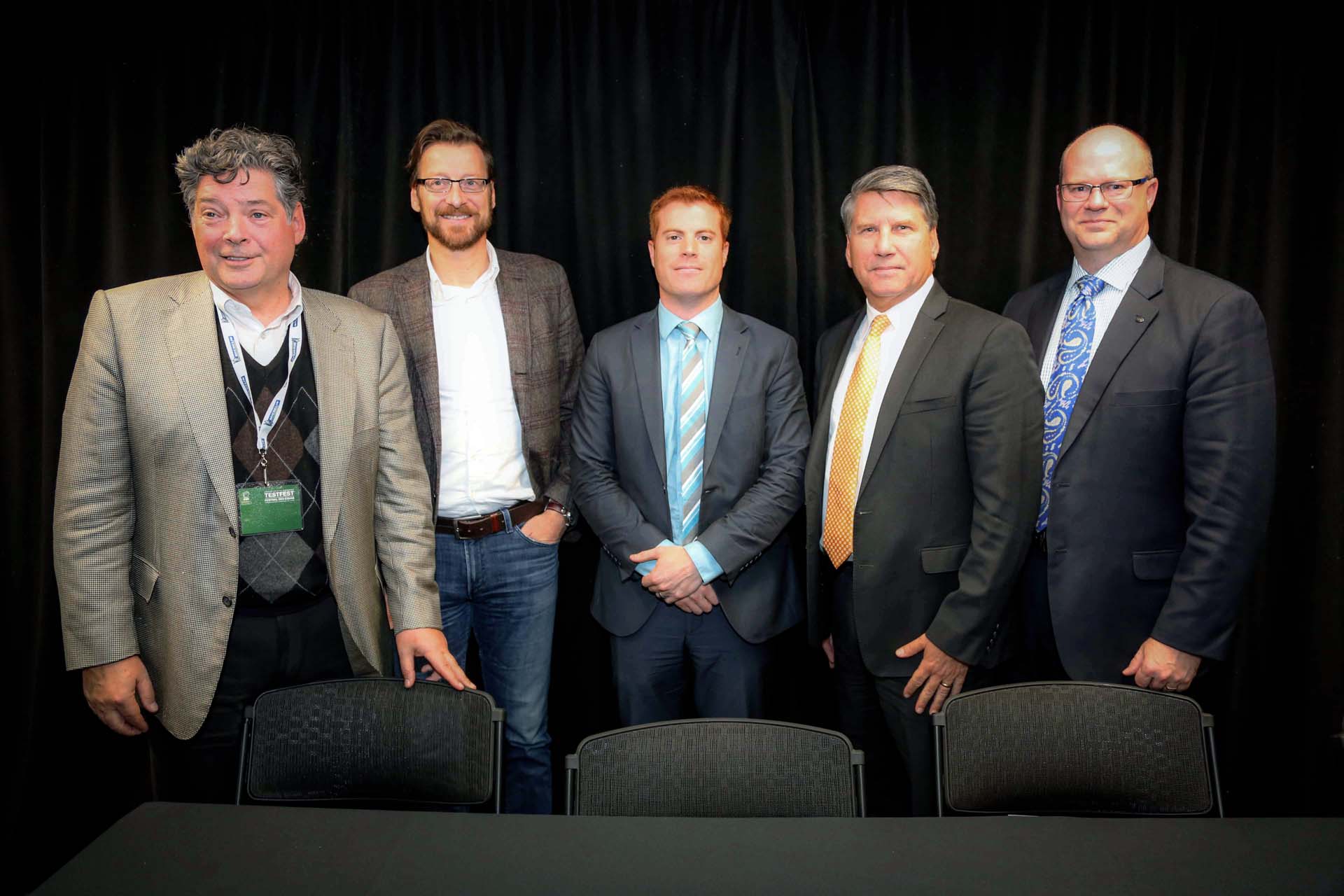 From left: David Paterson, Wolfgang Hoffmann, François Lefèvre, Don Romano, Ted Lancaster
From left: David Paterson, Wolfgang Hoffmann, François Lefèvre, Don Romano, Ted Lancaster
Electrification vs Fuel Cell Technology

The debate rages on: will electric cars catch on despite the current barriers of limited range and long recharge times; or, is it a better value to invest in the infrastructure needed for hydrogen fuel cell vehicles, which go further and are easier to recharge but will cost a great deal more up-front to make viable?
“General Motors, no surprise – I think we’re all in for the future of electrification,” Paterson said to kick off the discussion. “We’re proud to have been very successful here in Canada with the Chevrolet Volt, and we’re excited about coming out with the Chevrolet Bolt with 383 km of range. We think that the technology still has a lot of work to do, battery technology in particular, but it’s definitely going to be a part of the mix, not just because of government regulation but I think a lot of our customers are going to be excited about the technology going forward.”
Nissan’s Lefèvre said that one of the challenges of raising electric car use is simply dissemination of infrastructure and communicating incentives:
“What we’re looking at is all the people who are living all around the [downtown] core [of Toronto] like in Mississauga, Ajax, Whitby, Brampton. These are thousands and thousands of houses that could easily have a charging station. If these people would be aware of the Ontario program where they pay for half of the charging station, that would open the door.

“Not everyone should purchase an electric car today, depending on their needs,” says Lefèvre, citing challenges such as range and lack of access to a garage, car park or public charging stations – common among downtown dwellers. “But if you look at the average Canadian drive per day, it’s about 42 km, so a majority could actually consider it as one of their cars.”
Hyundai’s Romano offered the hydrogen counterpoint. Hyundai has invested heavily in fuel cell technology, and the first Canadian-owned hydrogen fuel cell Tucson was delivered early last year.
“Electric cars are becoming very popular,” he conceded. “Tesla has helped elevate the concept. And sure, we’re going to follow suit. We’re coming out with the brand-new Ioniq. It will be out in January.
“But let’s face it: there are limitations. The battery technology is not there right now. If your car goes 383 km and you need to go 390, there’s a problem.
“For a certain portion of the population, electric cars make sense. We’re going to build electric cars for that portion of the population. But long term, are we all going to be driving electric cars? Not until the battery technology changes dramatically.”
Romano feels that hydrogen fuel cell technology is the solution for several reasons: they have a range of up to 500 km, they can be filled in five minutes, and unlike electricity, hydrogen can be stored.
“We’re blessed in this country to be able to produce 80 percent of our electricity without a carbon footprint,” he explained. “The problem is it’s expensive. Here in Ontario we spend over $600 million a year in electricity that we can’t use. Every one of us living here in Ontario are paying that bill. Yes, we do dump it or sell it to neighbouring provinces or down to the States, but we sell it at a third of that price.
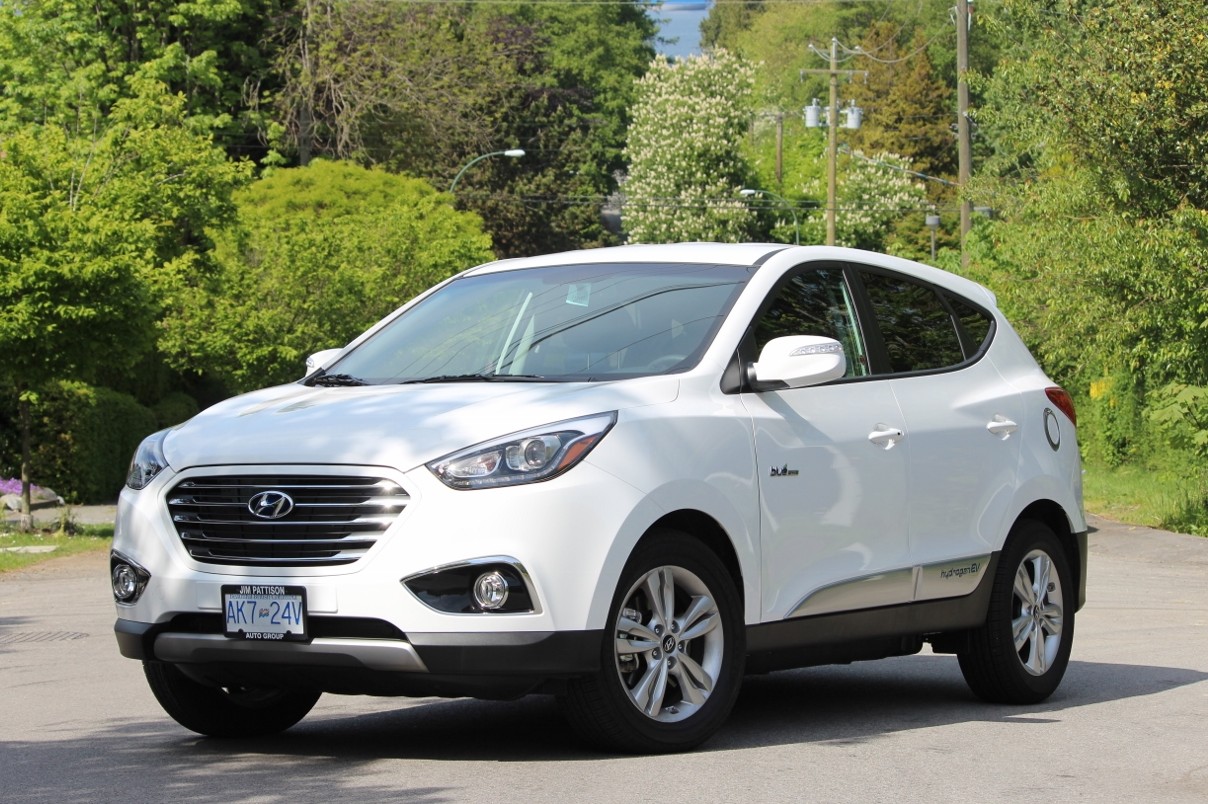
“You can take that $400 million and use that to invest in hydrogen storage capabilities, and now it’s available to you when you need it, whether it’s piped to your home or at a Shell station. The storage abilities are incredible, and the fact that we can produce it here with this excess electricity when it is available as opposed to selling it on the cheap I think just makes good sense for us.”
Quebec’s Bill 104 was also raised, which when unanimously passed by its legislature on October 26, 2016, made Quebec the first jurisdiction in Canada to stipulate a minimum sales volume for zero-emission vehicles. Automakers will need to generate ZEV credits equal to 3.5 percent of their sales in Quebec starting with the 2018 model year, a number that will rise to 15.5 percent by 2025.
“They have a surplus of electricity, so we know why that bill passed,” Lancaster said. “What they haven’t said is which vehicles qualify and what credits we’re going to get for those vehicles. At Kia, our goal right now is to be 25 percent better with our fuel efficiency by 2020, so we’re bringing in plug-in hybrids, we have hybrid vehicles, and we have the Soul EV. I think a lot of other OEMs have similar technologies and similar products.
“The 3.5 percent is derived from the number of credits for each vehicle that you sell. I think it is attainable so long as they get the credits right.”
Connectivity & Autonomous Driving
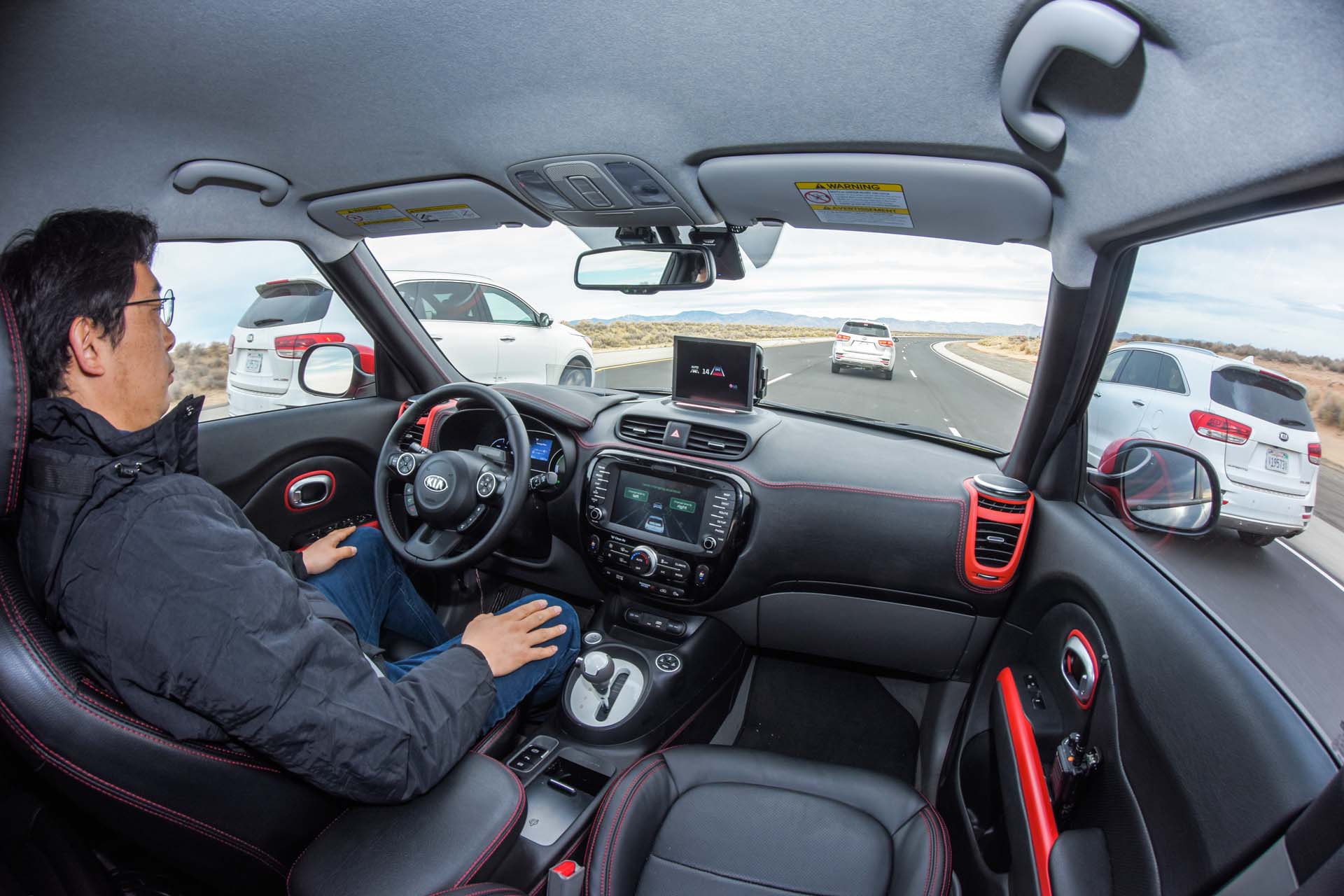
As much as the populace may be ready to accept autonomous vehicles, Canada’s automotive executives are extremely skeptical of the hurdles that remain in the way of their adoption.
“The big debate that we always look at is where does the responsibility lie, and that’s what the legislation is debating right now,” Kia’s Lancaster said. “Whose fault is it if you’re in an autonomous vehicle and the vehicle gets into an accident: the person who put it into the autonomous mode, so the driver, or is it the OEM because they’re the ones that said it shouldn’t get into the accident? I think that’s a debate that’s going to rage on for a number of years.”
“We’re not going to see a bunch of cars driving themselves in the next five years on the roads,” Romano added. “There are just too many obstacles. However, in the process of getting there we are going to see more and more safety systems and semi-autonomous systems brought to market helping us make the roads safer, helping people drive safer, and it’s going to just evolve. I think eventually we are going to see cars driving around the roads without drivers, but it’s going to take this evolutionary process before we get there.”
Jaguar’s Hoffmann said he simply doesn’t see the need for any urgency in the matter.
“No one is forcing us,” he said. “You need to be autonomous tomorrow. Why? I still can go to work. I can still do what I need to do. It’s nothing essential. It’s not life or death. I think some people out there are using it more as a marketing tool and a gag and saying, ‘Look how far we are, at the forefront of technology.’ With a technology like this, you can’t be irresponsible.
“If I make a mistake as a human being, I think that’s accepted. We all make mistakes. If the machine makes a mistake, what do you do then? And when was the last time your laptop crashed? How often do I have to reboot my phone because it doesn’t work? Do we really believe there will be no problems, no glitches?
“For me at least, and I’m old-fashioned, the one who sits behind the wheel is responsible. At one point or another, we have to use our brains. We can’t give that up and just assume that the technology takes care of everything.”
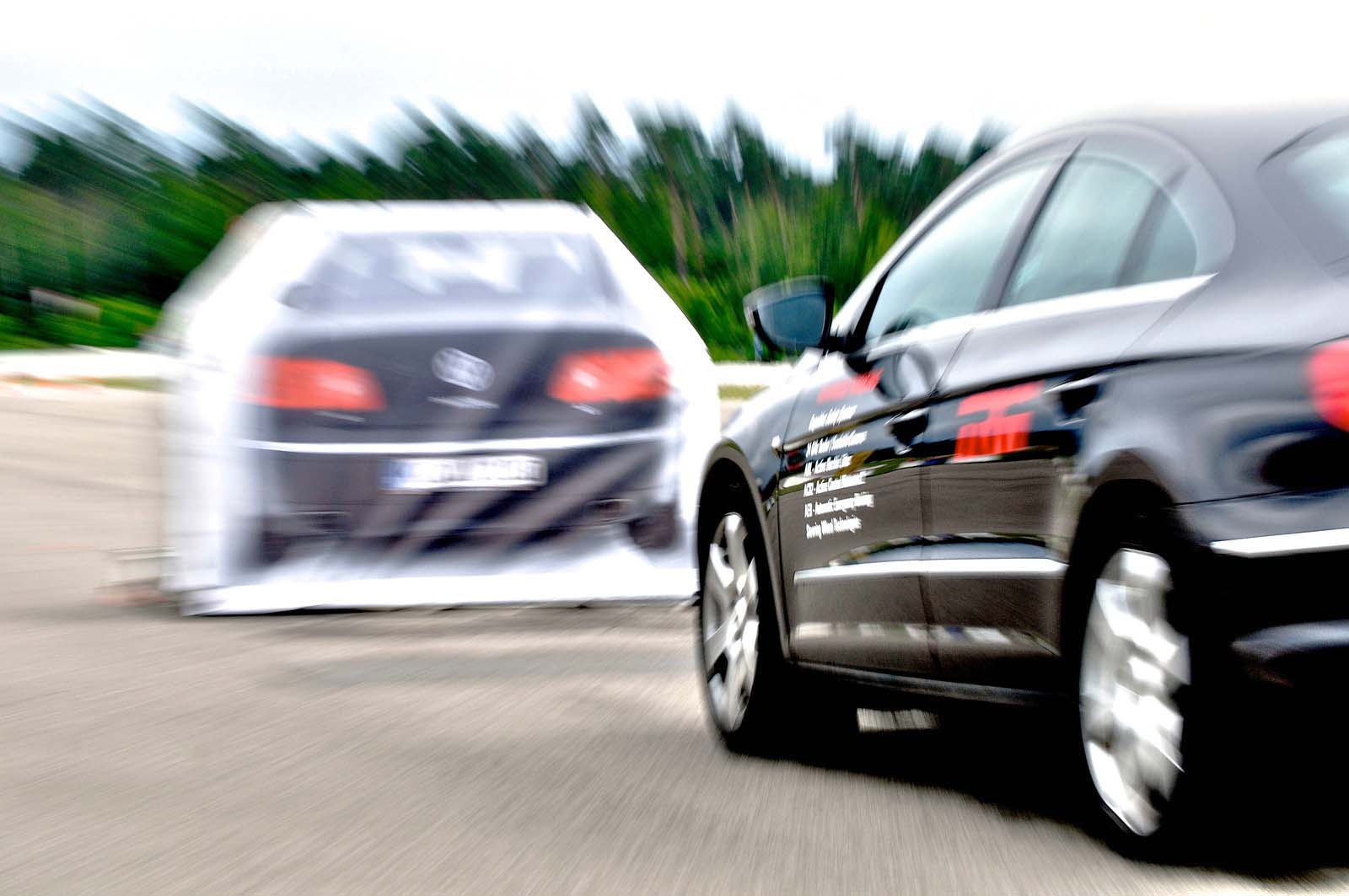
GM’s Paterson countered with a statistic: “We lose 35,000 lives a year because of driver error on the roads in North America,” he said. “I believe regulators have seen this is something they’re going to insist upon. My prediction would be in five years we’re going to be looking back at vehicles that are 10-years[-old] or older and we’re going to say they’re unsafe because they don’t have the ability to prevent crashes and save lives that the cars now coming out do.”
Lancaster expressed doubt that these emerging technologies will eliminate all crashes:
“I don’t know that, having autonomous vehicles, there won’t be any accidents ever again. We’re not in a world right now where we can test for that. And there’s going to be a test case for it, I have that feeling, and then whose fault is it? I think that’s what’s going to prevent this from getting wider traction faster – and I think a lot of people would like to see it get faster – because of that one outstanding question.”
Ride-sharing & Ownership

Is there truly a day coming when we’ll simply summon a car with a smartphone and not care whether we’ll ever call one our own?
“My daughter thinks you get a car from your smartphone,” Paterson says, “and that’s really the way a lot of people will think in urban centres in particular.”
Lancaster agreed. “Millennials aren’t buying cars right now,” he said. “I can use the app on my phone and I can get a car in a matter of minutes.”
“But I also strongly believe there will always be the fun of driving,” Hoffmann countered. “When I got my driver’s licence, I was excited. I hope that doesn’t go away and that people still want to drive and be in control.”

Romano shared an apt anecdote to spell out exactly where the divide lies in making car sharing universal.
“I’m not a big optimist when it comes to the future of car-sharing, and I base it on that I have two daughters, one in university and one who just graduated,” he explained. “The one in university, yeah, the Lyft and Uber and Maven solution right there with her phone makes a lot of sense.
“But the other daughter just graduated and she’s getting married, and the first thing she did was call me and said, ‘We need to get a car.’ It’s funny how things change when you move out of that environment.
“I want to go when I want to go, and that’s a privilege I’ve earned, I think, over life. I think a lot of people feel the same way. The whole ride-sharing thing, like electric cars, there’s a place for it. In an urban environment, with all the congestion and gridlock, it absolutely makes sense. Do I think it’s going to reflect the majority of the people in the world? No. We have moved almost into where driving is an inalienable right and we want to do it our way.”





